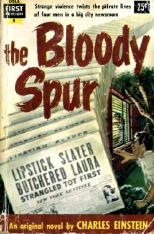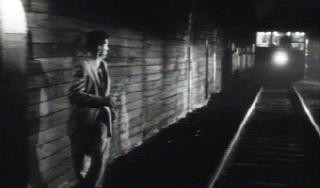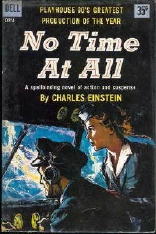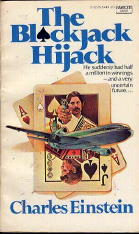Tue 13 Mar 2007
OBITUARY: Charles Einstein (1926-2007)
Posted by Steve under Authors , Crime Fiction IV , Obituaries / Deaths Noted[4] Comments
By profession a dedicated newspaperman and sportswriter, Charles Einstein also dabbled in writing mystery and crime fiction. He died last week, and a more fitting and heartfelt tribute to him could not be found anywhere than this one by crime writer Wallace Stroby, who was also his editor at The Newark Star-Ledger for several years, not to mention a very close friend.
You should read the entire piece yourself, of course, and I hope you will, but to illustrate what kind of interesting family Mr. Einstein came from, here are couple of paragraphs I’ve taken the liberty of excerpting from it:
“Charlie had two half-brothers as well, from his father’s second marriage – Albert Einstein and Bob Einstein. Albert, of course, eventually became writer/director/comedian Albert Brooks, and Bob went on to cable fame as ‘Super Dave Osborn’ and is now a regular on HBO’s Curb Your Enthusiasm.”
As a sportswriter, Charles Einstein was, among other honors, a lifetime member of the Baseball Writers Association of America. His works include four Fireside Books of Baseball, The New Baseball Reader, and (with Willie Mays) Born to Play Ball and My Life In and Out of Baseball.

As a mystery writer, his resume, while significant, is not nearly as extensive. Here’s a slightly expanded version of Mr. Einstein’s entry in Crime Fiction IV, by Allen J. Hubin:
EINSTEIN, CHARLES (1926-2007)
# Wiretap! (n.) Dell First Edition #76, pbo, 1955
# -The Last Laugh (n.) Dell First Edition A121, pbo, 1956
# No Time at All (n.) Simon & Schuster, hc, 1957. Dell, pb, 1958.
# The Naked City (co) Dell First Editon A180, pbo, 1959. Stories based on TV scripts by Stirling Silliphant.
• “Lady Bug, Lady Bug…”
• Line of Duty
• Meridian
• Nickel Ride
• The Other Face of Goodness
• Susquehanna 7-8367
• The Violent Circle
# The Blackjack Hijack (n) Random House, 1976. Fawcett Crest, pb, no date.
I called his resume “significant,” and here are some details to back up that statement. First the movies, then the books the films were based on:
THE MOVIES:
The Bloody Spur was made into the RKO movie While the City Sleeps, 1956, directed by Fritz Lang. A top-notch film noir / social criticism film about the role of the media (newspapers vs. TV) while a serial killer is on the loose, it sounds as though it should be on DVD but for some reason, it does not seem to be. The movie stars Dana Andrews, George Sanders, Ida Lupino, Vincent Price, Rhonda Fleming, Howard Duff, Thomas Mitchell and Sally Forrest.

No Time at All was filmed as an episode on Playhouse 90 in 1958. [See the cover of the paperback edition.] Available on video, an online description calls it: “A sort-of Airport of its time, this production tells of a stricken airliner that must make its way through the heaviest air traffic in the world without lights and radio. Among the cast members are William Lundigan, Jane Greer, Betsy Palmer, Keenan Wynn, Charles Bronson, Jack Haley, Buster Keaton, Chico Marx and Sylvia Sidney.”

The Blackjack Hijack was the basis for the TV movie Nowhere to Run, 1978, starring David Janssen, Stefanie Powers and Allen Garfield. Synopsis of the movie, paraphrased from IMDB: “To get out of his marriage with Marian, world-weary Harry plans to fake his death and assume a new identity. His wife gets suspicious and hires a private eye, but when Harry discovers this, he hires the PI to work for him instead.”
THE BOOKS:
The Bloody Spur. “‘Help me for gods sake.’ Later the doctors would use these words to decipher the riddle of a perverted killer. Right now, the lipstick scrawl signaled the start of New York’s greatest manhunt.
“And in the city room of the fabulous Kyne News empire, four big-time newsmen went into action. All four knew that an exclusive beat on the killings would mean the top job at Kyne – and they were all hungry for the job. Hungry enough to buck the police, sell out their mistresses, and commit blackmail. Four decent men – corrupted by the blood spur of ambition.”
Wiretap! “Men with a golden ear. In the city of Aimerly they were the cops, the city prosecutor, the rackets boss. Their electronic spies recorded the intimacies of boudoir and office – intimacies later priced, and paid for.in cash or blood. Then a judge who knew where all the bodies were buried got himself murdered. And Sam Murray, State Crime Commission, walked into a maze of tapped phones, secret cameras, hidden mikes. Various people tried to sidetrack Sam, with the help of two ladies who were specialists at their work. But when Sam kept pushing, they gave him a choice – rot in jail, or send the last honest man in town to do it for him.”
The Last Laugh. “Sam Prior was an off-stage straight man for Carl Anda and Jay-Jay Bailey, whom readers should be careful not to confuse with real-life entertainers, living or dead. And he was a straight man for his wife Rachel, whom he should have left where he found her, singing with her hips at a Borscht Circuit hotel. He tells his own story in his own words, warm and wry and funny. He’s a nice guy, and in the dog-eat-dog world of professional comics, they eat nice guys for breakfast.”

The Blackjack Hijack. About the author, taken from the dust jacket flap: “In a career that has included years as a wire-service newsman and feature writer in New York and Chicago, and as columnist and editor for two San Francisco dailies, Charles Einstein also has authored several hundred other works — books, screenplays, short stories, magazine articles. The Blackjack Hijack is his ninth novel and, he notes, the first in which he appears as a character in his own book, playing the part of an expert on the game of blackjack. Here art imitates life: in 1968 author Einstein published another book – now in its fourth printing and hailed by ranking computer programmers and other mathematicians as the best and simplest in the field — called How to Win at Blackjack. Both born in New England in the late 1920’s, the author and his wife first met as undergraduates at the University of Chicago, and with their four children, now all in their twenties, migrated subsequently from New York to Arizona to California.”
March 21st, 2007 at 4:28 pm
[…] 21 Mar 2007 Bill Pronzini on CHARLES EINSTEIN and MIKE SHAYNE. Posted by Steve under Authors , Characters After posting my comments onCharles Einstein after his death, I mentioned to Bill Pronzini that as I remembered it, he was the one who’d told me to read Einstein’s first crime novel, The Bloody Spur. We’re speaking 30 to 35 years ago, mind you. Here’s Bill’s reply: […]
September 5th, 2010 at 2:17 am
Charlie Einstein and I were fellow campers at Deer Lake Camp, Madison, Connecticut in 1938 and following years. When most of us arrived at camp, Charlie greeted us with, “Do you any of you guys play baseball?” He was 12 years old at the time! Our baseball was only softball but we had a great time. Charlie was a great guy and I regret that I was never able to contact him again.
November 13th, 2012 at 11:34 am
We said the same thing-‘do any of you guys play baseball?’ in 1940. I am writing a story about my time at Deer Lake. Would love to talk to you.
February 11th, 2013 at 4:44 pm
It’s amazing how two people can be related and know so little about each other.
He died when I was seven.
I just remember my father(Jeffery Einstein, youngest son of Charles Einstein) sobbing into his hands, I just remember being extremely confused since I’d never seen him cry.
I have great memories of sitting and playing the piano with him, while he sang of his walking stick. He also showed me his old type writer and I remember it being so foreign, I found it magical.
Now I know where I got my love of baseball.